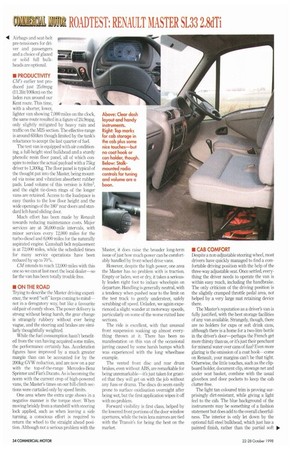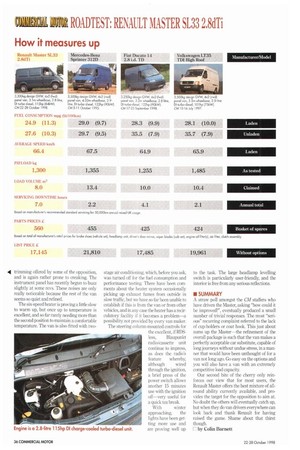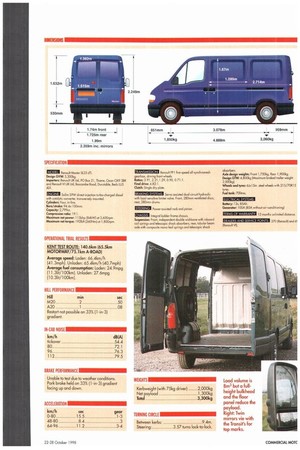SOFT 8t STIZONC
Page 35

Page 36

Page 38

Page 37

If you've noticed an error in this article please click here to report it so we can fix it.
Six months ago CM road-tested Renault's new version of the Master. On a short acquaintanc we were impressed. Now CM has lived with c different model over a longer period.
When CM originally tested an example of the new Master van range (CM 2-8 April), we found little to criticise beyond some rather disappointing fuel consumption figures. A healthy dose of journalistic cynicism left us with the feeling that maybe the new Master was too good to be true and that we might have missed something. The only way to find out for sure was to live with one for an extended test period. Our initial road test was of a long-wheelbase, highroof model, so this time we went to the opposite end of the range and a short, low-roof version, again with turbo-diesel power.
Il PRODUCT PROFILE Since its UK launch at the beginning of this year, the Master range has remained almost unchanged, comprising vans with three wheelbas-es from 3.1 to 4.1m, three heights and three gross weights-2.8, 3.3 and 3.5 tonnes. The two lowest versions have conventional steel roofs, while the higher has a moulded composite roof cap. Chassis-cab, chassis-cowl and platform-cab versions are available for specialist bodying and the range has just been completed with the introduction this month of a crewcab variant.
Engine choice is from a pair of Sofim sourced eight-valve OHC a5-litre 80hp (60kW) naturally aspirated inditx injection unit and a 2.8-litre 115hp (84k direct-injection, charge-cooled turbo-die The gearbox is a five-speed cable-opera' unit in a light alloy casing.
Front suspension is by double wishboi with an ingenious rocker system operati coil springs mounted inside the chassis tr at the rear of the engine subframe. The ri end is more conventional, with a tubular be axle suspended from leaf springs steel 2.8-tonners and composite on the larger 1; sions, which also have anti-roll bars front a rear.
The van bodies are constructed on an ir gral steel box section chassis and have eaF. replaced sill and valance panels. Additio protection is afforded by the plastic lowers mouldings. Security is helped by the stand:, unglazed rear doors and a transponder-t5 immobiliser. All of the doors are controlled remote central locking, although the transn ter has limited power and needs the aim c Bisley-standard marksman to operate fi time.
Standard safety features include thr point inertia-reel seat-belts and hc restraints for each occupant, a fuel cut. inertia switch, high-mounted brake light a a half-width mesh guard behind the dris
• PRODUCTIVITY Cilfs earlier test produced just 25.0ropg (11.3lit/100km) on the laden run around our Kent route. This time, 0
with a shorter, lower, lighter van showing 7,000 miles on the clock, the same route resulted in a figure of 24.9mpg, only slightly mitigated by heavy rain and traffic on the M25 section. The effective range is around 650km though limited by the tank's reluctance to accept the last quarter of fuel.
The test van is equipped with air conditioning, a full-height steel bulkhead and a sturdy phenolic resin floor panel, all of which conspire to reduce the actual payload with a 75kg driver to 1,300kg. The floor panel is typical of the thought put into the Master, being mounted via noise and vibration absorbent rubber pads. Load volume of this version is 8.0m3, and the eight tie-down rings of the longer vans are retained. Access to the loadspace is easy thanks to the low floor height and the wide openings of the 180" rear doors and standard left-hand sliding door.
Much effort has been made by Renault towards reducing maintenance costs. Major services are at 36,000-mile intervals, with minor services every 12,000 miles for the turbo-diesel and 6,000 miles for the naturally aspirated engine. Camshaft belt replacement is at 72,000 miles, while the scheduled times for many service operations have been reduced by up to 70%.
CM intends to reach 12,000 miles with this one so we can at last meet the local dealer—so far the van has been totally trouble free.
• ON THE ROAD Trying to describe the Master driving experience, the word "soft" keeps coming to mind— not in a derogatory way, but like a favourite old pair of comfy shoes. The power delivery is strong without being harsh, the gear change is strangely rubbery without ever being vague, and the steering and brakes are similarly thoughtfully weighted.
While the fuel consumption hasn't benefited from the van having acquired some miles, the performance certainly has. Acceleration figures have improved by a much greater margin than can be accounted for by the 200kg GVW reduction, and are now on a par with the top-of-the-range Mercedes-Benz Sprinter and Fiat's Ducat°. As is becoming the norm with the current crop of high-powered vans, the Master's times on our hill-climb sections were curtailed only by speed limits.
One area where the extra urge shows in a negative manner is the torque steer. When moving briskly from a standstill with steering lock applied, such as when leaving a side turning, a conscious effort is required to return the wheel to the straight ahead position. Although not a serious problem with the Master, it does raise the broader long-term issue of just how much power can be comfortably handled by front-wheel drive vans.
However, despite the high power, one area the Master has no problem with is traction. Empty or laden, wet or dry, it takes a seriously leaden right foot to induce wheelspin on departure. Handling is generally neutral, with a tendency when pushed near to the limit on the test track to gently understeer, safely scrubbing off speed. Unladen, we again experienced a slight wander at motorway speeds, particularly on some of the worse rutted lane sections.
The ride is excellent, with that unusual front suspension soaking up almost everything thrown at it, There has been no manifestation on this van of the occasional jarring caused by some harsh bumps which was experienced with the long wheelbase example.
The vented front disc and rear drum brakes, even without ABS, are remarkable for being unremarkable—it's just taken for granted that they will get on with the job without any fuss or drama. The discs do seem easily prone to surface oxidisation overnight after being wet, but the first application wipes it off with no problem.
Forward visibility is first class, helped by the lowered front portions of the door window apertures, while the twin lens mirrors are tied with the Transit's for being the best on the market. • CAB COMFORT Despite a non-adjustable steering wheel, most drivers have quickly managed to find a comfortable driving position with the help of the three-way adjustable seat. Once settled, everything the driver needs to operate the van is within easy reach, including the handbrake. The only criticism of the driving position is the slightly cramped throttle pedal area, not helped by a very large mat retaining device there.
The Master's reputation as a driver's van is fully justified, with the best storage facilities of any van available. Strangely, though, there are no holders for cups or soft drink cans, although there is a home for a two-litre bottle in the driver's door—perhaps the French get more thirsty than us, or it's just their penchant for mineral water over cans of fizz? Even more glaring is the omission of a coat hook—come on Renault, your margins can't be that tight. Otherwise, the little touches, such as the clipboard holder, document clip, stowage net and under seat basket, combine with the usual glovebox and door pockets to keep the cab clutter-free.
The light tan coloured trim is proving surprisingly dirt-resistant, while giving a light feel to the cab. The blue background of the instruments may be something of a fashion statement but does add to the overall cheerfulness. The interior is only let down by the optional full steel bulkhead, which just has a painted finish, rather than the partial soft trimming offered by some of the opposition, and is again rather prone to creaking. The instrument panel has recently begun to buzz slightly at some revs. These noises are only really noticeable because the rest of the van seems so quiet and refined.
The six-speed heater is proving a little slow to warm up, but once up to temperature is excellent, and so far rarely needing more than the second position to maintain a comfortable temperature. The van is also fitted with two
stage air conditioning, which, before you ask, was turned off for the fuel consumption and performance testing. There have been comments about the heater system occasionally picking up exhaust fumes from outside in slow traffic, but we have so far been unable to establish if this is from the van or from other vehicles, anti in any case the heater has a recirculatory facility if it becomes a problem-a possibility not provided by every van maker.
The steering column-mounted controls for the excellent, if RDS less, Blaupunkt radio/cassette unit continue to impress, as does the radio's feature whereby although wired through the ignition, a brief press of the power switch allows another 15 minutes use with the ignition off-very useful for a quick tea break.
With winter approaching, the lights have been getting more use and are proving well up to the task. The large headlamp levelling switch is particularly user-friendly, and the interior is free from any serious reflections.
• SUMMARY
A straw poll amongst the CM staffers who have driven the Master, asking "how could it be improved?", eventually produced a small number of trivial responses. The most "serious" recurring complaint referred to the lack of cup-holders or coat hook. This just about sums up the Master-the refinement of the overall package is such that the van makes a perfectly acceptable car substitute, capable of long journeys without undue stress, in a manner that would have been unthought of for a van not long ago. Go easy on the options and you will also have a van with an extremely competitive load capacity.
Our second bite of the cherry only reinforces our view that for most users, the Renault Master offers the best mixture of allround ability currently available, and provides the target for the opposition to aim at. No doubt the others will eventually catch up, but when they do van drivers everywhere can look back and thank Renault for having raised the game. Shame about that thirst though. E by Colin Barnett
SPECIFICATION
EMI Renault Master S133 dii Design GVW: 3,300kg.
Importers: Renault UK ltd. PO Box 21, Thome, Oxon 0X9 3BR and Renault VI UK Ltd, Boscombe Rood, Dunstoble, Beds 1U5 4LX 1=11 Sofim 59W direct-injection turbo-charged diesel witt catalytic converter, transversely mounted Cylinders: Four, in-line Bore/stroke: 94.4x 100mm Capocity-, 2,799cc.
Compression ratio: 19,1.
Maximum net power: I 15bhp(841/W) at 3.600/Pm
Maximum net torque: )921b1t(2dONm)at 1,80Orpm. EZE=119 Renault PF1 five-speed all-synchromesh gearbox, driving front wheels.
Ratios: 3 91, 2.21,1.29, 0.90, 0.71,1, Final drive: 4.82:1.
Clutch: Single dry plate.
ITIMEHIM Servo assisted dual-circuit hydraulic iutio ser,s1hve I,v,mer valve. Front, 280mm ventilated ass, reor, 280mm drums.
MEE Power-assisted rack and pinion.
MEM Integral ladder-frame chassis. Suspension: Front, independent double wishbone with inboard coil springs and telescopic shock absorbers, rear, tubular beam axle with composite mono-leaf springs and telescopic shock absorbers.
/We design weights: Front 1,750kg Rear 1,900kg Design G1W: 4,800kg (Maximum braked trailer weight 2,000kg) Wheels and Inas: &NI 5m steel wheels with 215/70R15 tyres
Fuel tank: 701itre,
Battery: ..
Generator . _Jt sir conditoning) EIT.E=MISS1 months unlimited distance DEALERS AND SERVICE POINTS 370 /Renault) and 6'
OPERATIONAL TRIAL RESULTS
KENT TEST ROUTE: 140.6km (65.5km MOTORWAY/75.1km A-ROAD) Average speed: Laden66.4km/h (41 3mph). Unladen. 65.4km/h (40.7mph) Average fuel consumption: Laden: 24.9mpg (11.31it/100km). Unladen: 27.6mpg (10.31it/100km).
HILL PERFORMANCE
Hill min sec M20 2 50 A20 1 08 Restart not possible on 33% (1-in-3) gradient.
IN-CAB NOISE
km/h dB(A)
tickover 54.4 BO 72.1 96 76.3 112 79.5 BRAKE PERFORMANCE Unable to test due to weather conditions. Park brake held on 33% (1-in-3) gradient facing up and down.
ACCELERATION km/h 0-80 48-80 64-96
SSC
15.5 8.4 11.2 gear 1-3 3-4 WEIGHTS Kerbweight (with 75kg driver) 2,000kg Net payload 1,300kg Total 3,300kg TURNING CIRCLE Between kerbs: 9.4m.
Steering3.57 turns lock-to-lock.
















































































































